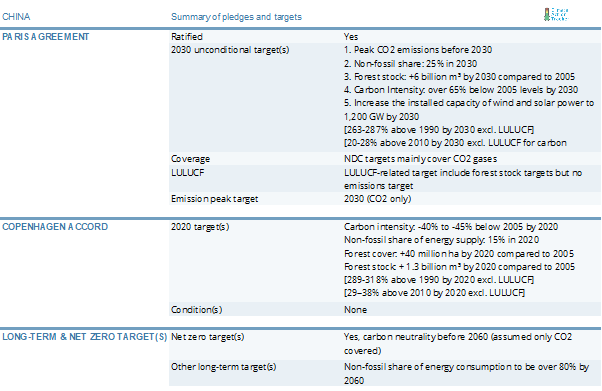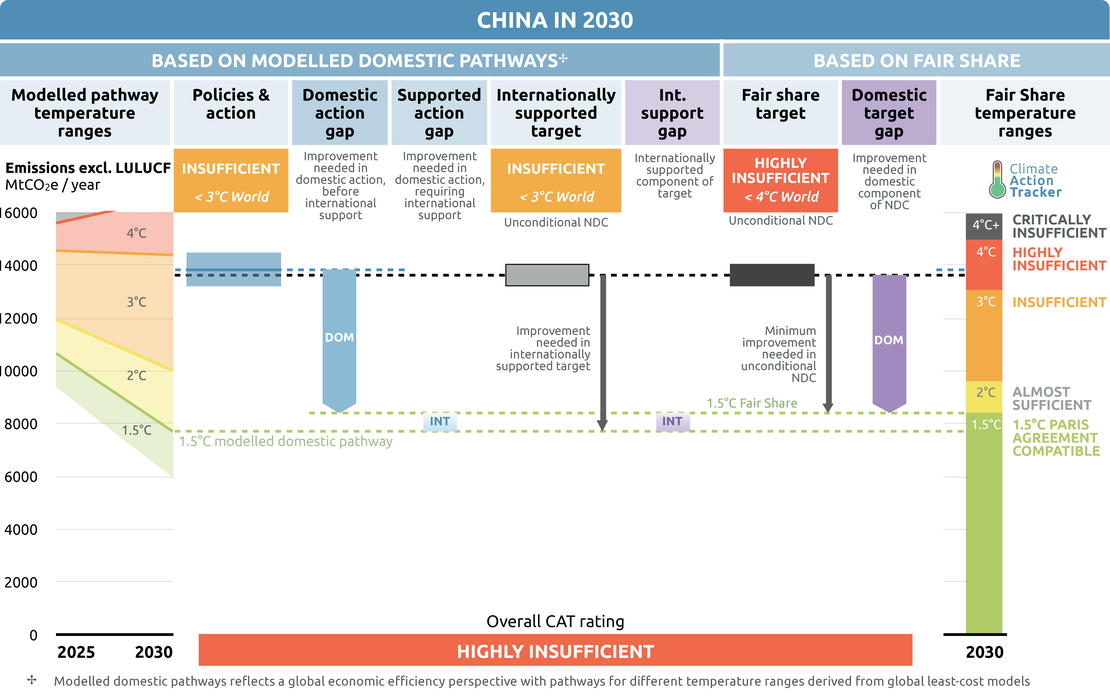Targets
Paris Agreement targets
NDC description
On 28 October 2021, China officially submitted its updated NDC to the UNFCCC, reflecting the new targets Chinese President Xi Jinping proposed at the 2020 Climate Ambition Summit. The CAT rates these targets as “Highly Insufficient” under fair share criteria, unchanged from the First NDC. While the NDC update has strengthened and expanded the previous 2030 target, including an increase in ambition from China compared to current policies, China’s targets still result in anticipated emissions rising, rather than falling, to 2030.
The NDC update is an improvement from its first NDC and would lead to an increase in ambition compared to current policies. According to our analysis, achieving China’s most binding NDC targets (peaking and non-fossil share) would lead to emission levels of 13.2 to 14.0 GtCO2e (in AR4 excl. LULUCF) in 2030 (20% to 28% above 2010 levels), which is within the range of China’s current policy projections (13.2 to 14.5 GtCO2e in 2030, equivalent to 20% to 32% above 2010 levels).
China’s updates to its NDC targets are:
- Peaking carbon dioxide emissions “before 2030”, (up from “around 2030 and making efforts to peak earlier”).
- Lower carbon dioxide emissions per unit of GDP by “over 65%” in 2030 compared to 2005 levels, (up from “by 60- 65%”).
- Share of non-fossil fuels in primary energy consumption to “around 25%” in 2030, (up from “around 20%”).
- Increase forest stock volume by around 6 billion cubic metres in 2030 from 2005 levels, (previously 4.5 billion cubic metres).
- Bring its total installed capacity of wind and solar power to a total of 1.2 billion kilowatts by 2030.
China’s updated NDC targets mainly targets CO2 gases (which indirectly addresses some non-CO2 gases as well), and thus omits significant emissions from agriculture and industry. While the NDC also mentions measures to effectively control non-CO2 gases such as methane, HFCs, nitrous oxide, and sulfur hexafluoride, there are no numerical targets for these at this time.
Under China’s most binding peaking and non-fossil share NDC targets, the country’s emission levels would reach between 13.2 to 14.0 GtCO2e in 2030. The lowered NDC emissions range (compared to when targets were first quantified during the 2020 announcement) is due to our inclusion of positive energy sector policy developments and revision of China’s post-COVID GDP and emission trends. For China’s NDC pathway in our global aggregation, we use a single value to estimate the emissions level if all four NDC targets were met. We use the average of China‘s peaking and non-fossil share targets (13.6 GtCO2e) as they are the most binding targets and the most realistic emissions trajectory is captured within the range.
Comparing China’s expected emission levels from its NDC commitments to global least cost modelled domestic pathways downscaled to the country level, the CAT rates China’s domestic target in 2030 as “Insufficient”. This rating takes into account that China has effectively submitted an unconditional NDC target but has not indicated a level of emissions that would be achieved with international support (a conditional NDC target). The “Insufficient” rating indicates that China’s domestic target in 2030 needs substantial improvements in ambition to be consistent with the Paris Agreement’s 1.5°C temperature limit. If all countries were to follow China’s approach, warming would reach over 2°C and up to 3°C. This rating takes into account that a fraction of China's domestic target consistent with the Paris Agreement 1.5 degree limit would need international support.
China’s emission levels under its NDC commitments are substantially higher than what would be deemed Paris compatible compared to our “fair share” approach, resulting in our rating of “Highly Insufficient”.
The “Highly insufficient” rating indicates that China’s fair share target in 2030 lead to rising, rather than falling, emissions and is not in line with any interpretation of a fair approach to meeting the Paris Agreement’s 1.5°C limit. We base our rating on China’s NDC commitment to peak CO2 and achieve 25% non-fossil fuels in its primary energy mix by 2030, along with other major implemented policies. If all countries were to follow China’s approach, warming could reach over 3°C and up to 4°C. <PMs to add link to fair share>.
Were we to base the NDC rating on the carbon intensity target only, it would also be “Highly insufficient,” but the absolute emissions level of this element of the NDC is highly uncertain as it depends on GDP growth.
In any event, the present level of unconditional commitment falls substantially short of the commitment that would be consistent with China's fair share contribution to meeting the Paris Agreement's goals.
Whether China should or should not receive some climate finance from abroad to reduce its emissions is a matter of debate. Our methods do not provide a clear answer to this question, although on balance the CAT methodology shows that China needing small but important international support is consistent with the wide range of literature on fair share contributions to meeting the Paris Agreement's goals (the figure above shows it to receive a small contribution). In any case, the NDC target achieved with own resources would need to be increased significantly to be in line with the 1.5°C limit.
Further information on how the CAT rates countries (against modelled pathways and fair share) can be found here.
Last NDC update
China has officially submitted an updated NDC to the UNFCCC, although President Xi Jinping announced the draft new NDC back in December 2020 (CGTN, 2021). China’s updated NDC targets are now quantified in our assessment.

Net zero and other long-term target(s)
We evaluate the net-zero target as: Poor.
China’s President Xi Jinping first announced his country’s commitment to reach “carbon neutrality before 2060” in a declaration at the UN General Assembly in September 2020 (FMPRC, 2020). In October 2021, China officially submitted its Mid-Century Long Term Low Greenhouse Gas Emission Development Strategy. The Long Term Strategy (LTS) seems to confirm its emissions coverage only for carbon dioxide in the official submission, whereas previously the CAT assumed the coverage was for all GHGs. A net zero target aiming for zero carbon dioxide emissions in 2060 would mean that other countries have to reach net zero CO2 well before 2050. If China’s net zero target were to cover all GHG emissions, its long-term strategy could be within range of mid-century Paris Agreement compatible emissions levels, although compatibility also depends on the shape of the pathway (Yvonne Deng et al., 2020). Due to the size of China’s emissions, this difference can make up to 0.1°C more or less warning in 2100. Given that the LTS submission does not meet the majority of our considerations for a best-practice approach in LTS formulation, we evaluate China’s net-zero target as “Poor”.
2020 Pledge
China’s 2020 pledge consists of the following elements:
- Overall reduction of CO2 emissions per unit of GDP by 40–45% below 2005 levels by 2020;
- Increase the share of non-fossil fuels in primary energy consumption to around 15% by 2020;
- Increase forest coverage by 40 million hectares and forest stock volume by 1.3 billion cubic metres by 2020 from 2005 levels.
The CAT’s calculations show that the 2020 carbon intensity target represents a range of 14.1 to 15.2 GtCO2e in 2020, which was overachieved according to our 2020 emissions estimate (13.8 GtCO2e). This is due primarily to enhanced climate policy, as China’s rapid recovery from the COVID-19 pandemic led to increased emissions. For details of how we quantify China’s NDC targets, please see the assumptions section.
Summary table

Further analysis
Latest publications
Stay informed
Subscribe to our newsletter





